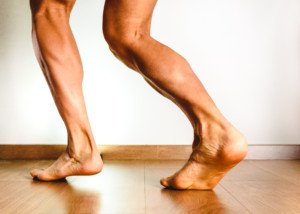
When you look at your thenar palm area (right below the thumb) do you see dents that are suggestive of muscle atrophy?
“The thenar portion of the palm is the thick muscle portion just below the thumb,” says Walter Gaman, MD, FABFM, board certified in family medicine and the author of several award-winning books including “Age to Perfection: How to Thrive to 100, Happy, Healthy, and Wise.”
Muscle Atrophy Can Happen in the Thenar Palm Area
Dr. Gaman continues, “When this area becomes indented or atrophied it is often a sign of carpal tunnel syndrome. This happens because the median nerve, the nerve that supplies the muscle, has become damaged, usually from overuse.
“In some instances this damage has occurred over time and without proper correction, leading to permanent damage.”
An EMG test can determine if the perceived atrophy in the thenar palm area is only that: perceived, or, if it’s true atrophy (which would be generated by carpal tunnel syndrome).

EMG test. Credit: Shutterstock/Roman Zaiets
Another possible cause of muscle shrinkage in the palm below the thumb is pronator teres syndrome.
This condition, like carpal tunnel syndrome, also involves compression of the median nerve – but higher up in the arm.
However, this very uncommon condition can still cause the same symptoms as carpal tunnel syndrome.
If you have either CTS or PTS, there will very likely be other symptoms, not just the atrophy dents in the palmar thenar area.
CTS and PTS may also cause pain in the wrist, and numbness and/or tingling in the thumb, index or middle finger.
PTS can cause pain and tingling in the forearm. Weakness may also result from either condition.
Muscle Atrophy vs. Asymmetry in the Palm’s Thenar Area
Dr. Gaman explains, “Some people have one thenar palm area that is smaller than the other. This can either be an asymmetrical anomaly they were born with, or it can be due to overuse of one hand.
“Thenar indention with pain, tingling or numbness should be discussed with your healthcare provider so that you can be checked for carpel tunnel syndrome.”
If you don’t have these additional symptoms but are certain that you can clearly see “atrophy,” it’s very likely just benign asymmetry due to natural anatomy or overuse of that hand.
What you think is muscle wasting might actually be slightly more muscle development in a dominant hand, and this could create dents.
This would be akin to the dent created under a biceps muscle when it’s flexed.
Do not keep staring at the area below your thumb and fear the worst. It’s a naturally fleshy and soft area, and anything that’s naturally fleshy and soft will have some degree of dents.
If you still can’t shake the anxiety, then exercise both hands with a handgrip device. This can give you reassurance.
If you feel any pain or tingling, think in terms of carpal tunnel syndrome or possibly pronator teres syndrome rather than a serious neurological disease.

Dr. Gaman is with Executive Medicine of Texas and is with the Staying Young Radio Show 2.0 podcast.
 Lorra Garrick has been covering medical, fitness and cybersecurity topics for many years, having written thousands of articles for print magazines and websites, including as a ghostwriter. She’s also a former ACE-certified personal trainer.
Lorra Garrick has been covering medical, fitness and cybersecurity topics for many years, having written thousands of articles for print magazines and websites, including as a ghostwriter. She’s also a former ACE-certified personal trainer.
.


























